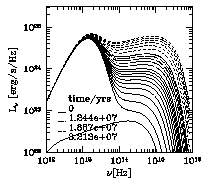
Accretion Disk Evolution With Wind Infall I. General Solution and Application to Sgr A*
Heino Falcke (1), & Fulvio Melia (2)
(1) Department of Astronomy, University of Maryland, College Park, MD 20742-2421, USA(2) Department of Physics & Steward Observatory, University of Arizona, Tucson, AZ 85721 (melia@as.arizona.edu)
The Astrophysical Journal, Vol. 479, 740
Abstract:
The evolution of an accretion disk can be influenced significantly by the deposition of mass and angular momentum by an infalling Bondi-Hoyle wind. Such a mass influx impacts the long-term behavior of the disk by providing additional sources of viscosity and heating. In this paper, we derive and solve the disk equations when these effects are taken into account. We present a survey of models with various wind configurations and demonstrate that the disk spectrum may then differ substantially from that of a standard alpha -disk. In particular, it is likely that a wind-fed disk has a significant infrared bump due to the deposition of energy in its outer region. We apply some of the results of our calculations to the Galactic Center black hole candidate Sgr A* and show that if a fossil disk is present in this source, it must have a very low viscosity parameter (alpha <~ 10,-4) and the Bondi-Hoyle wind must be accreting with a very high specific angular momentum to prevent it from circularizing in the inner disk region where its impact would be most noticeable.
Paper: Available as PostScript and LaTex (AAS LaTex) Format.
Other publications can be found here.
Questions: Heino Falcke, hfalcke@astro.umd.edu